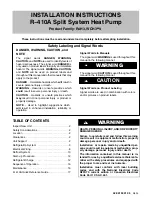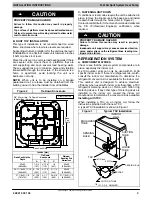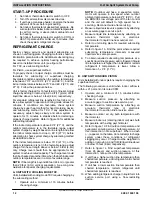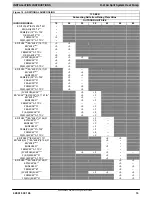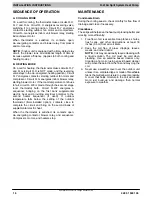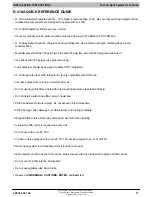
INSTALLATION INSTRUCTIONS
R
−
410A Split System Heat Pump
4
428 01 5301 05
Specifications subject to change without notice.
Installing with Indoor Piston
−
cooling operation.
(Heat pumps also use an outdoor piston for heating
operation, refer to section F.)
Check piston size shipped with indoor unit to see if it
matches required indoor piston size shown on outdoor
unit rating plate.
If it does not match, replace indoor piston with
cooling
piston, according to size marked on outdoor unit rating
plate. (Some outdoor models include a cooling piston in
the accessory bag.)
Heating piston is shipped in the service valve
−
refer to
section F.
Example fan coils with piston: FEM4P, FSM4P, FSU4P,
FMA4P, FMC4P, FMU4P, WAPM, WAPT, WAPL, WAMA,
WAMC.
See Figure 2.
When changing indoor piston, use a back
−
up wrench.
Finger tighten hex nut, then tighten with wrench 1/2 turn.
Do not exceed 30 ft
−
lbs (40.7 N
−
m).The indoor piston
contains a Teflon ring (or seal) which is used to seat
against the inside of distributor body, and must be
installed properly to ensure proper seating in the direction
for cooling operation.
Figure 2
Indoor (cooling) Piston
TEFLON SEAL
BRASS
HEX NUT
STRAINER
PISTON
RETAINER
BRASS
HEX BODY
DISTRIBUTOR
PISTON
FLOW IN
COOLING
TEFLON RING
L10S017
!
CAUTION
PRODUCT OPERATION HAZARD
Failure to follow this caution may result in improper product
operation.
If using a TXV in conjunction with a single
−
phase reciprocat-
ing compressor, a compressor start capacitor and relay are
required. Consult outdoor unit pre
−
sale literature for start as-
sist kit part number.
B. REFRIGERANT LINE SETS
The refrigerant line set must be properly sized to assure
maximum efficiency and proper oil circulation.
Refer to Product Specifications and Long Line
Applications Guideline for line set sizing
.
NOTE:
Total line set length must not exceed 200 feet
(61m).
NOTE:
A crankcase heater must be used when the
refrigerant line length exceeds 80 feet (24.4m).
If outdoor unit is more than 10 feet (3m) higher than the
indoor coil, refer to the Long Line Applications Guideline
for instructions.
NOTE:
When the outdoor unit is higher than the indoor
coil, the vertical separation must not exceed 100 feet
(30m).
NOTE:
When the outdoor unit is lower than the indoor
coil, the vertical separation must not exceed 50 feet
(15.2m).
If it is necessary to add refrigerant line in the field, use
dehydrated or dry, sealed, deoxidized, copper
refrigeration tubing. Do not use copper water pipe.
Do not remove rubber plugs or caps from copper tubing
until connections are ready to be made.
Be extra careful when bending refrigeration tubing.
Tubing can “kink” easily, and if this occurs, the entire
length of tubing must be replaced.
!
WARNING
PERSONAL INJURY HAZARD
Failure to relieve system pressure could result in
personal injury and/or death.
Relieve pressure and recover all refrigerant before
servicing existing equipment, and before final unit
disposal. Use all service ports and open all flow
−
control devices, including solenoid valves.
!
CAUTION
UNIT OPERATION HAZARD
Failure to follow this caution may result in improp-
er product operation.
Do not leave system open to atmosphere any lon-
ger than absolutely required for installation. Inter-
nal system components
−
especially refrigerant
oils
−
are extremely susceptible to moisture con-
tamination. Keep ends of tubing sealed during
installation until the last possible moment.
C. ROUTING AND SUSPENDING REFRIGERANT
LINES
Run refrigerant lines as straight and direct as possible,
avoiding unnecessary bends and turns. Always insulate
the entire suction line. Both lines should be insulated
when routed through an attic or when routed through an
underground raceway.

